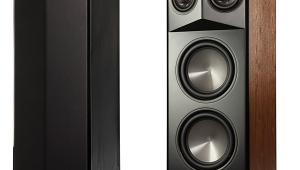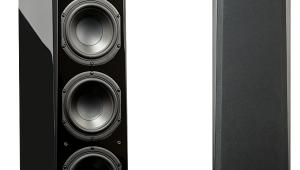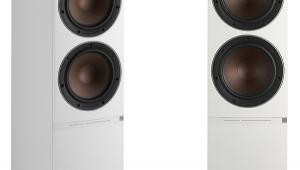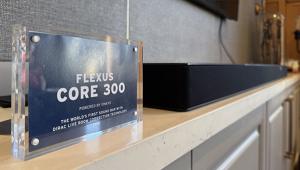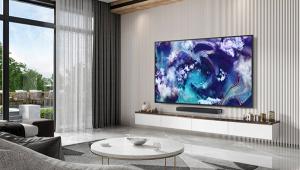Thank you for sharing this amazing piece of content. You are doing a great job, thanks for itThe Crow Jacket
Arendal 1723 Speakers and Subwoofer 2V: Sublime Sounds

PRICE $10,146 (complete system)
AT A GLANCE
Plus
Understated elegance
Precision crafted
Incredibly detailed sound
Well thought out design
Minus
Bring friends when unpacking and installing
Price could put a dent in your wallet
App still doesn’t like me
THE VERDICT
Words like entertaining, fun, captivating and commanding can all be used to describe what the Arendal 1723 series is capable of. The overall sense is of a company that took their time to get it right, and then executed the plan to near perfection. There aren’t many instances where I struggle to find flaws, but with Arendal it’s a challenge to do so. It feels a little like deja vu for me, that’s the same conclusion I had with their smaller 1723 S system. Guess brilliance runs in the family.
I’m moving up in the world it seems. In March of 2023 I published an article on Arendal Sound’s 1723 S speakers and 2S subwoofer, one step below the flagship 1723 and 2V subwoofer. I was impressed with the brand and their products back then, I felt the S series was something special.
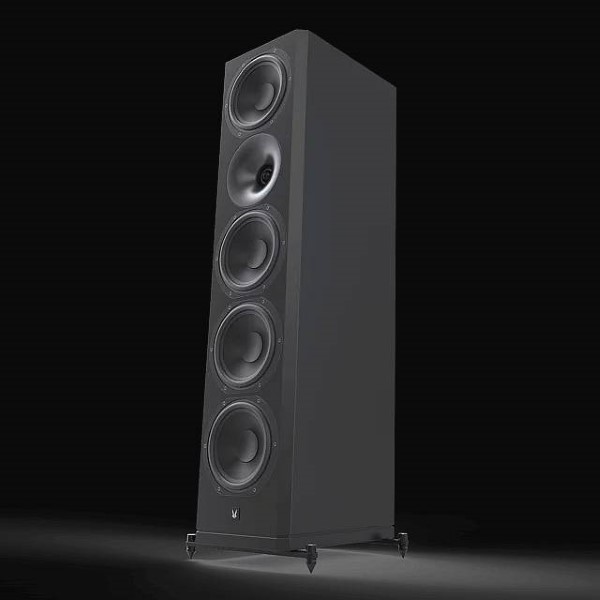
Fast forward to June of 2024, when I was offered the opportunity to evaluate the company’s flagship products, and naturally, I said yes. Now, staring me in the face at this very moment are the following: two 1723 Tower THX speakers, a 1723 Center THX speaker, two 1723 Surround THX speakers, and a 1723 Subwoofer 2V.
The 1723 Tower retails for $3,899 a pair, the Center runs $1,299, Surrounds cost $1,849 a pair and the 2V subwoofer goes out the door for $3,099. All told, that’s a shade over 10 grand of product in my home theater. For some folks that’s getting into rarefied air, but bear in mind this is their ultimate system; everything I have is at the top of its respective category in the Arendal line.
So what premium extras do you get for that money? Here are some of the highlights: a 60-day in-home trial, free global shipping on orders over $500/€500, discounted upgrades during the first year of ownership, a 5-year warranty on electronics with 10 years for everything else, and a 60-day price guarantee.
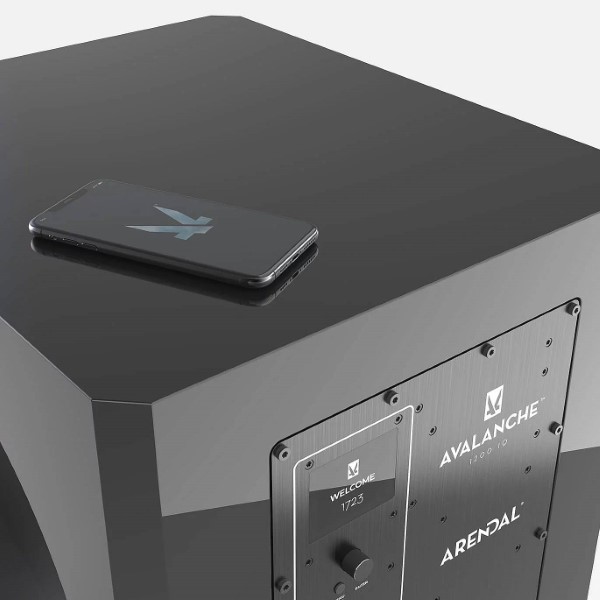
There’s actually more, for the full list check out Arendal’s website. As you go over the benefits pay close attention to how many are after the sale. That part is particularly noteworthy in my opinion. Anyone can play nice while you’re contemplating a purchase, and as you’re making one, but there aren’t many that go the extra mile once you’ve spent the money.
Impressions
I’ll bet many among you read articles like this and think something along the lines of “I would love to do product reviews”. Really? Let’s take a step behind the curtain and see what you’re in for.
When you add everything up this Arendal 1723 system weighs about 500 pounds unboxed, that’s a quarter of a ton. Before you can review anything, you have to get it inside your home. That entails moving those hundreds of pounds of delicate and expensive equipment from wherever the delivery company left them to your door (I say “where the delivery company left them” because the entire system comes on pallets. That might limit their options to someplace far from your door. Once inside it all has to be unboxed, which is always a joy. The towers are double boxed, so you get twice the fun with those. Be sure to memorize how the packing is done, or take pictures, you’ll need that later when it’s time to send everything back.
If your HT is large enough to unpack all this in the same room where you’ll be using it then you are almost done with the physical part. If you have to unpack in a different room you better start planning on how you can get everything from point A to point B before you even begin. Hand truck, dollies, packing blankets, I have it all. Once you free everything and have moved the boxes to one side of the room at least an hour has passed, and now you’re perspiring. But there’s still a ways to go, no relaxing just yet.
Now you have to move all of your own gear out of the way to make room for the review system. Once everything has been cleared away, carefully replace it with the Arendal equipment. I say “carefully” because it’s not mine, certainly I don’t want to damage anything. Now hook up the wires, run room EQ and then make some final adjustments so it sounds right. At last, time to sit down and enjoy the fruits of your labor.
Not so fast, first I have to find a spot for this mountain of boxes and packing material I pushed off to the side wall. Are we there yet? Nope, we’re not even half way. Now you have to do the actual evaluation, write the entire article and submit that, unhook the whole system, reconnect my system and tune it, repack everything from Arendal, get it onto the pallets again and ship the whole lot back. I’m exhausted just typing that. The takeaway is that product reviews are difficult, time consuming, painstaking work. Why bother then? Because sometimes it’s worth the effort.
You may be asking yourself, what does any of that have to do with my thoughts on Arendal? Before I can even have an impression, I first have to go through all of that. If I do and there’s no fun to be had during the evaluation, I’m not a happy camper. But I did enjoy myself this time - quite a bit actually - so the juice was definitely worth the squeeze. Now that I’ve gotten it off my chest, let me tell you about my impressions.
Arendal makes speakers and subwoofers that can readily be described with words like stylish and subtle. They look elegant without being flashy, upmarket but not pretentious. The black satin paint on the towers and center are offset by the very gentle curve of the cloth grill, all of which results in a refined look. The edges of the cabinets have a 45° bevel which softens the blocky appearance of most enclosures. The grills are held in place with magnets, no unsightly pin/cup arrangement here. Both the 2V subwoofer and 1723 towers are not what you would call small, yet they somehow blend in with their surroundings. The 2V wears the same satin black paint and also sports beveled edges. The consistency across the product line makes for a cohesive look. If black satin paint isn’t your thing you can also get them in white satin. A gloss finish, in either black or white, is also an option.
To stabilize the towers attach the included outriggers, they come with both carpet spikes and rubber pads. You can use them to level the speakers in order to fine tune their placement. They are classy looking pieces with a high quality feel. For the center and surrounds, Arendal includes two different sizes of stick-on rubber feet.
With their narrow cabinets everything shows a slender face to the listener, even the 2V subwoofer. Its dual-opposed drivers are on either side of the enclosure so it too is relatively slim. The surround speakers are the only outlier, those are shaped like an Isosceles trapezoid. They use the same paint scheme and curved grill as the rest of the speaker line, along with their own version of the beveled corners. I guess in that regard they’re not paternal twins, but more like fraternal twins instead. The towers have a neat feature whereby they tilt back at a 2.5° angle to ensure they’re aimed directly at your ears while seated. All the enclosures are made from HDF rather than the typical, and less dense, MDF. The more rigid material helps dampen resonances, decreasing sympathetic distortion made by cabinet panel vibrations.
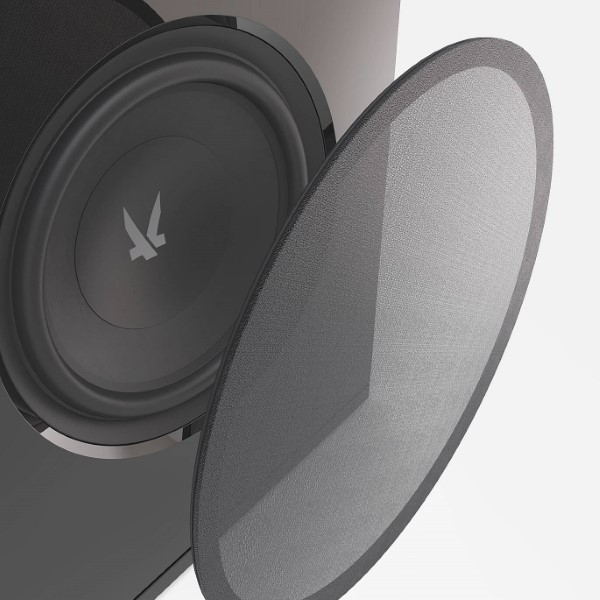
I would be remiss if I didn’t mention Arendal’s documentation. I went into great detail about it in my 1723 S series article, if you want a deep dive that would be a good read for you. But I did want to bring up the topic again as a refresher, especially for those who typically don’t bother with documentation. Do yourself a favor, read what Arendal provides. It is a clinic on how you’re supposed to do it, everything from the content to the material they use for the handbook is first rate. And let’s not forget their impish sense of humor. I mean, these folks have somehow made the world’s largest land carnivore seem cute. Poke around a little bit, you’ll see what I mean.
Setup
I’ve been going on about so many good things Arendal does, and there are many, that now I feel compelled to start this section in the opposite direction.
For whatever reason, Arendal’s subwoofer app does not like me. I had problems when I reviewed the 1723 2S, and I had problems with this 2V. My phone is still the same - a Samsung S20 - but it’s probably had 10 updates since I looked at the 2S in the beginning of 2023. I would imagine Arendal has updated their app several times since then too, so why it still has it out for me is a mystery.
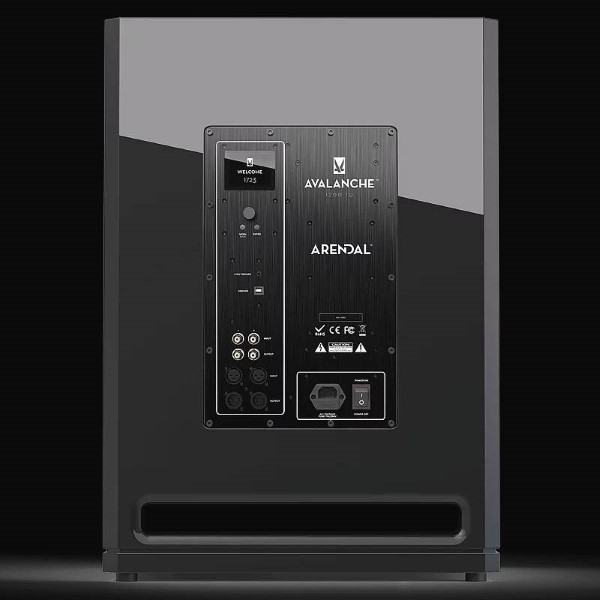
Installation was pretty much like every phone app, a breeze. The initial sync with the 2V went without a hitch, once connection had been established with the subwoofer all the controls physically worked; +/- would visually increase or decrease, sliders tracked my finger like they should, every menu responded correctly, etc. All seemed well, trouble is nothing was happening on the amplifier end. From the app it sure looked as if things were being changed, but in reality they were not. I marched over to the sub and was able to use the physical controls on the amp and change things to my heart’s content. After doing so I checked their corresponding settings on the app, lo and behold they matched what I had set on the subwoofer.
Once I had gone down that path I could then control the amp using the app. Mostly. There were times after that when I tried to tweak something from the app, yet it would again ignore me. I found in those instances I could just go into the settings menu on the amp itself, not change a single thing, and suddenly the app would work again (note to self… if the app syncs to the sub you can no longer use the controls on the amp to make adjustments, you have to close the app before proceeding).
Despite some difficulties I’ve encountered with it, the app provides a wealth of functionality through an intuitive interface, offering features like seven individual PEQs, crossover adjustments, an input selector for XLR or RCA, input gain control, level adjustments, a lowpass filter with an adjustable slope, phase control, a standby timer with wake-up sensitivity, and a subsonic filter with an adjustable slope.
The towers and center give you the option of running in sealed or ported mode, the later having multiple variations affording you the ability to tune them for whatever works in your situation. The center has 2 ports, so 3 possible configurations; sealed, 1 port open or 2 ports open. The towers have 3 ports, giving you 4 potential variations. Arendal includes very dense plugs for each of the ports, all of which fire out the back of the enclosure. That goes for the 2V subwoofer as well, its port is also on the back of the enclosure. If you’re at all concerned about “chuffing” - port noise - don’t be oriented that way, it’s all but guaranteed you would never hear it even if there was any.
The binding posts on all the speakers are the same, perhaps the best word to describe them is beefy. They’re made from polished, CNC machined copper which is then plated with highly-conductive, and corrosion resistant, Rhodium. However you want to hook them up you can; banana, spade or pin type connectors, as well as bare wire. There are 2 sets of posts on each speaker allowing you to bi-amp them. If you choose not to go that route Arendal supplies stout Rhodium jumpers to bridge the posts.
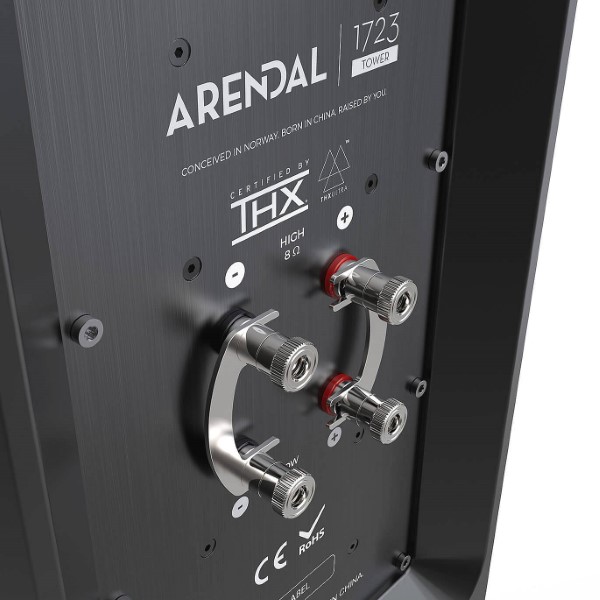
The terminal plate those brawny binding posts are attached to is anodized aluminum with a chic brushed finish. It provides a rigid base that is free from resonance. The plate seems unusually large until you realize the crossover is actually mounted to it. This allows Arendal to change components and make upgrades significantly easier for their customers.
Listening/In Use
At the risk of showing my hand too early… anyone who has ever read my previous reviews that included speakers knows perhaps my number one evaluation criteria is voices. For more years than I will admit to, my thought has been if speakers can’t do voices correctly they likely can’t do much else right. Seems rather drastic? Perhaps, but in my mind, a human voice is the sound our ears can most identify with. For as long as we’ve been able to hear there have been voices, evolution has honed our auditory acuity to identify the spoken word. Think guitars have been around for 5,000 years? Nope, but people speaking some type of language certainly have. You may not put the same emphasis on that aspect as I do, and that’s fine, but for me the sound of voices has to be dead on; weight, pitch, timbre, all of it. If a speaker fails there it’s probably going to fail elsewhere.
Why the long-winded lead in to this section? So you’ll know that what I’m about to say shouldn’t be taken lightly; the Arendal 1723 speakers have a preternatural ability to reproduce the human voice. I was smiling ear-to-ear on more occasions than I can count. Whether it was a simple TV show, a movie or a song, I was like a kid in a candy store. There were times when it seemed like a veil of imprecision had been lifted, and what was previously muddled or barely intelligible became clear and obvious. All voices—and in the case of music, vocals—were sublime. Rather than bore you over and over again saying that for each movie and music selection below, just consider that last sentence a blanket statement.
The tweeter in the 1723 series is a 1.1-inch synthetic dome nestled inside a waveguide. According to Arendal that waveguide “provides a more consistent polar response across the tweeter’s entire range”. Sitting in the main listening position (MLP) you get all the goodness from the center channel. Move slightly to the left or right - like to either side of the MLP, in the seats next to it on a couch for example - and all is still good. Venture much further out and the soundstage does compress a little, there is some audible loss of depth and detail as well. The people in those spots would have to be pretty discerning to notice however.
Movies
As I had done last year with the 2S, I unleashed Edge of Tomorrow with the subsonic filter disabled on the Subwoofer 2V. Doing that with the 2S, which is sealed, isn’t quite as reckless as doing it with the 2V, which is ported. Trapped air inside the cabinet of a sealed subwoofer adds a bit more damping and can impart a little more control over driver movement when pushed really hard trying to reproduce difficult material at high volume. A ported alignment doesn’t benefit from that phenomenon, because of that it’s easier to push a driver to the point where it can go beyond its mechanical limits. If left unchecked that can cause physical damage, which is why companies like Arendal add a subsonic filter; basically it’s there to protect people from themselves (or limit the negative affects of ultrasonic artifacts that might make their way into a soundtrack). But my job is to find flaws so I turned that filter off and cranked the volume. If I’m going to risk blowing out my back moving this system around then I might as well have some excitement along the way.
I had my fun alright, but rest assured the 2V was never in harm’s way. The Arendal protection mechanisms worked perfectly, even without the subsonic filter it never lost composure. I did get an incredible amount of bass, along with several of my windows rattling, but that was the extent of the theatrics. The 5th and lowest of the pulsating cycles in the opening scene did roll off a bit, but that’s all I noticed. I got what I was hoping to, and without any unnecessary drama.
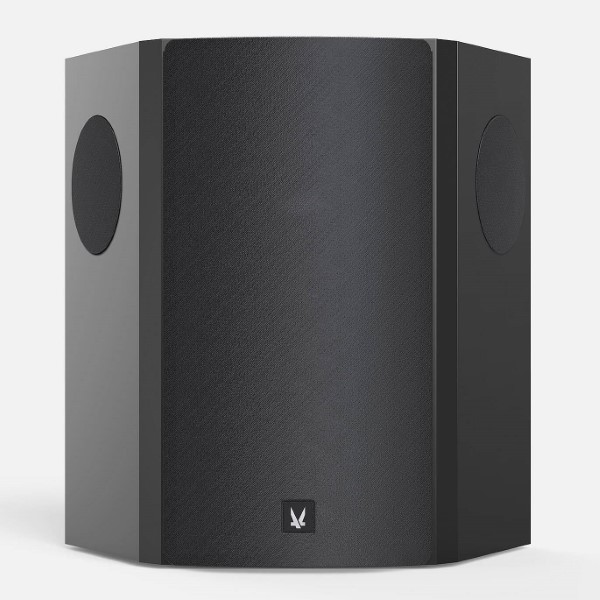
In The Dark Knight Rises Batman is in hiding, a self-imposed exile in response to everyone’s reaction after taking the fall for Harvey Dents murder. At one point the cops are chasing Batman on his motorcycle when he turns into an alley. As all the pursuit vehicles start arriving on the scene you could distinctly hear the whirring and chirping of the sirens echoing off buildings, their tires screeching as they came to an abrupt halt. Suddenly the motorcycle transforms into an aerial vehicle and rockets out of the alley, the pulsating from its engine reverberated throughout my room. It also has a whistling sound that pierced right through the deep undertone it was making.
During the movie Olympus there’s a siege on the White House. Supporting the attack is a North Korean military transport plane doing low flybys over the streets of Washington, DC. Its engines produced a very deep rumbling sound from the 2V subwoofer. At one point it gets shot down, as it crashes into the ground the impact and subsequent explosion were even more pronounced. The 2V isn’t done yet however, when the Washington Monument collapses things got even more intense. The orchestral soundtrack played along the entire time, the 1723 towers made it easy for that to be heard over the din from the mayhem. Voices coming from the radios were loud and clear, sounds from automatic weapons rang out all around me.
After what I said at the beginning of the Listening section I couldn’t help but slipping in a movie that was nothing other than a test of Arendal’s ability with voices. For this I went to the wayback machine and dug up the 1975 classic Jaws. I did so for one particular scene and one individual performance; Robert Shaw’s portrayal of Captain Quint. Quint is leading the charge to hunt down the killer shark, along for the ride with him are Amity Island’s sheriff Martin Brody (Roy Scheider) and oceanographer Matt Hooper (Richard Dreyfuss). One night the men are sitting around a table in the cabin of the boat, it’s obvious they’re inebriated. Under those circumstances people tend to slur their speech, that’s layer number 1 Arendal has to cut through. Then there’s Quint’s British accent and low tone, those are layers number 2 and 3. Couple that with 1970’s audio technology and you’ve got a mountain to climb.
At one point Quint launches into his experience while stationed aboard the USS Indianapolis. Things get solemn in a hurry, it’s at this point where I typically have difficulty understanding him while he gives a heart-wrenching speech about what happened. But not today, this time I heard it all and it was brilliant. A 1 minute scene in a roughly 2 hour movie might seem insignificant when evaluating a system, but without hearing what Quint says you lose the true definition of his character in this film. I don’t want to strain to hear any voice, even when there are some obstacles for the speakers to overcome. I definitely didn’t on this day.
Music
Radiohead’s “Creep” is an interesting number, a slow melody that also has a lively a guitar piece which can come across as almost out of place. That characteristic is why I keep going back to this one when testing speakers, getting that part right isn’t easy. The snare drum at the beginning had a nice crisp sound to it, the vocals seemed to hover directly above it. The bass guitar was fluid and rich. The aforementioned ‘lively’ guitar piece, which is often referred to as ‘crunches.’ leapt out of the speakers with authority. That isn’t the hard part though, clarity is often where a set of speakers will struggle. The Arendal 1723 had no such problem, this was one of the best renditions I have heard to date.
Wanting to speed up the pace a little I reached for “Fire Woman” from The Cult, a band that has had so many members they might as well be a real cult. The guitar gently opens this one, then the bass and drums start bringing the tempo up. As the intensity increased so did my grin. Despite the rhythm section getting raucous, the guitars were never overshadowed. Like Creep, the snare drum was not to be denied. The low end had distinct authority, yet Ian Astbury’s vocals still pierced through it all.
Conclusion
I’ve been evaluating audio gear for about a dozen years now, which means you know who my friends and family go to when they need advice. I’m always careful about what I say, sometimes people will spend a considerable amount of money based solely on my guidance. That’s a lot of pressure so I proceed with caution. There aren’t many brands I recommend unhesitatingly, but one of those just happens to be Arendal. They seem to get everything right; looks, engineering, sound quality, features, these folks miss nothing.
- Log in or register to post comments


Knowing what are leo satellites used for provides insights into their applications in communication, navigation, and environmental monitoring https://dragonflyaerospace.com/what-are-some-applications-of-a-leo-satellite/. These satellites offer critical data that enhances technological advancements and improves global connectivity across various sectors.

Branded tote bags are an excellent promotional tool for businesses, combining style and practicality. These reusable bags offer ample space for logos, slogans, and creative designs, ensuring your brand stands out. Perfect for events, giveaways, or daily use, they provide an eco-friendly alternative to plastic bags. With their durability and versatility, branded tote bags make an impression, turning everyday activities into a powerful marketing opportunity for your brand.

Thank you for sharing this amazing piece of content. You are doing a great job, thanks for it حساب المعدل













